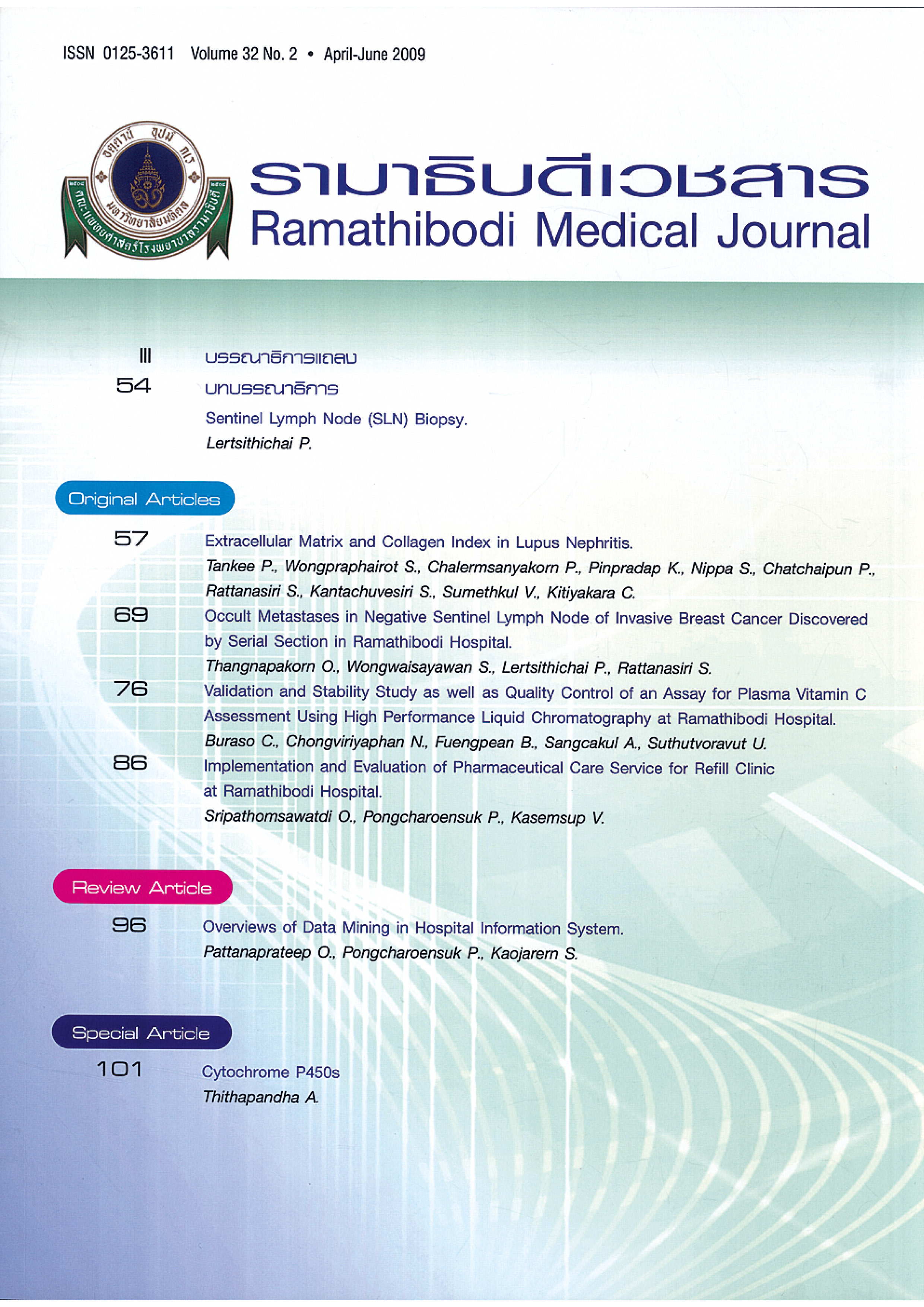Validation and Stability Study as well as Quality Control of an Assay for Plasma Vitamin C Assessment Using High Performance Liquid Chromatography at Ramathibodi Hospital
Keywords:
Vitamin C, Ascorbic acid, Hogh performance liquid chromatography, Stability methodAbstract
Background: L-ascorbic acid content in plasma is widely accepted as an indicator for vitamin C (VC) status. We set up a method using high performance liquid chromatography (HPLC) to improve the accuracy of plasma VC assessment at Ramathibodi Hospital. The objectives of this study were to validate the method and to determine the stability of VC in blood samples.
Subjects and methods: Heparinized 225-mL plasma was extracted from healthy volunteers. The levels of VC were quantified using a HPLC system with UV detector at the wavelength of 245 nm. For stability analysis, aliquots of the extracts, which were preserved with 10% meta-phosphoric acid and stored at -70oC, were analyzed until the day 15th after collection.
Results: Using our method. the percentage of accuracy was between 101.14 and 105.90%. Percentage of precision was 0.47%, on the same day, and 2.34 %, on a different day. Limit of detection (LOD) and limit of quantification (LOQ) were 0.07 and 0.23 mg/mL, respectively. The linearity for VC concentrations, ranging from 1 - 40 mg/mL, had the correlation coefficient of 0.9997. The stability analysis in this study showed that VC levels remained stable at -70oC for 2 weeks.
Conclusion: We demonstrated that our method provided the good accuracy and precision as well as acceptable LOD and LOQ for VC analysis with a small volume of plasma. Plasma kept for 2 weeks at -70oC could be analyzed for levels of VC. Therefore, this method is suitable for vitamin C assessment in patients, especially padiatric patiants, and researches
References
Bsoul SA, Terezhalmy GT. Vitamin C in health and disease. J Contemp Dent Pract. 2004;5(2):1-13.
Linster CL, Van Schaftingen E. Vitamin C. Biosynthesis, recycling and degradation in mammals. FEBS J. 2007;274(1):1-22. doi:10.1111/j.1742-4658.2006.05607.x.
Grollman AP, Lehninger AL. Enzymic synthesis of L-ascorbic acid in different animal species. Arch Biochem Biophys. 1957;69:458-467. doi:10.1016/0003-9861(57)90510-6.
Prockop DJ, Kivirikko KI, Tuderman L, Guzman NA. The biosynthesis of collagen and its disorders (first of two parts). N Engl J Med. 1979;301(1):13-23. doi:10.1056/NEJM197907053010104.
Hitomi K, Tsukagoshi N. Role of ascorbic acid in modulation of gene expression. Subcell Biochem. 1996;25:41-56. doi:10.1007/978-1-4613-0325-1_3.
Rebouche CJ. Ascorbic acid and carnitine biosynthesis. Am J Clin Nutr. 1991;54(6 Suppl):1147S-1152S. doi:10.1093/ajcn/54.6.1147s.
Manku MS, Oka M, Horrobin DF. Differential regulation of the formation of prostaglandins and related substances from arachidonic acid and from dihomogammalinolenic acid. II. Effects of vitamin C. Prostaglandins Med. 1979;3(2):129-137. doi:10.1016/0161-4630(79)90080-6.
Ramirez J, Flowers NC. Leukocyte ascorbic acid and its relationship to coronary artery disease in man. Am J Clin Nutr. 1980;33(10):2079-2087. doi:10.1093/ajcn/33.10.2079.
Englard S, Seifter S. The biochemical functions of ascorbic acid. Annu Rev Nutr. 1986;6:365-406. doi:10.1146/annurev.nu.06.070186.002053.
Levine M, Dhariwal KR, Washko P, et al. Ascorbic acid and reaction kinetics in situ: a new approach to vitamin requirements. J Nutr Sci Vitaminol (Tokyo). 1992;Spec No:169-172. doi:10.3177/jnsv.38.special_169.
Peterkofsky B. Ascorbate requirement for hydroxylation and secretion of procollagen: relationship to inhibition of collagen synthesis in scurvy. Am J Clin Nutr. 1991;54(6 Suppl):1135S-1140S. doi:10.1093/ajcn/54.6.1135s.
Eipper BA, Stoffers DA, Mains RE. The biosynthesis of neuropeptides: peptide alpha-amidation. Annu Rev Neurosci. 1992;15:57-85. doi:10.1146/annurev.ne.15.030192.000421.
Evans P, Halliwell B. Micronutrients: oxidant/antioxidant status. Br J Nutr. 2001;85 Suppl 2:S67-S74.
Tannenbaum SR, Wishnok JS. Inhibition of nitrosamine formation by ascorbic acid. Ann N Y Acad Sci. 1987;498:354-363. doi:10.1111/j.1749-6632.1987.tb23774.x.
Prockop DJ, Kivirikko KI, Tuderman L, Guzman NA. The biosynthesis of collagen and its disorders (second of two parts). N Engl J Med. 1979;301(2):77-85. doi:10.1056/NEJM197907123010204.
Pimentel L. Scurvy: historical review and current diagnostic approach. Am J Emerg Med. 2003;21(4):328-332. doi:10.1016/s0735-6757(03)00083-4.
Bates CJ. Plasma vitamin C assays: a European experience. EC FLAIR Concerted Action No. 10: Micronutrient Measurement, Absorption and Status. Int J Vitam Nutr Res. 1994;64(4):283-287.
Pachla LA, Reynolds DL, Kissinger PT. Analytical methods for determining ascorbic acid in biological samples, food products, and pharmaceuticals. J Assoc Off Anal Chem. 1985;68(1):1-12.
Romeu-Nadal M, Morera-Pons S, Castellote AI, López-Sabater MC. Rapid high-performance liquid chromatographic method for Vitamin C determination in human milk versus an enzymatic method. J Chromatogr B Analyt Technol Biomed Life Sci. 2006;830(1):41-46. doi:10.1016/j.jchromb.2005.10.018.
Chung WY, Chung JK, Szeto YT, Tomlinson B, Benzie IF. Plasma ascorbic acid: measurement, stability and clinical utility revisited. Clin Biochem. 2001;34(8):623-627. doi:10.1016/s0009-9120(01)00270-3.
Lee W, Davis KA, Rettmer RL, Labbe RF. Ascorbic acid status: biochemical and clinical considerations. Am J Clin Nutr. 1988;48(2):286-290. doi:10.1093/ajcn/48.2.286.
Margolis SA, Duewer DL. Measurement of ascorbic acid in human plasma and serum: stability, intralaboratory repeatability, and interlaboratory reproducibility. Clin Chem. 1996;42(8 Pt 1):1257-1262.
Maia AM, Baby AR, Yasaka WJ, Suenaga E, Kaneko TM, Velasco MV. Validation of HPLC stability-indicating method for Vitamin C in semisolid pharmaceutical/cosmetic preparations with glutathione and sodium metabisulfite, as antioxidants. Talanta. 2007;71(2):639-643. doi:10.1016/j.talanta.2006.05.006.
Shabir GA. Validation of high-performance liquid chromatography methods for pharmaceutical analysis. Understanding the differences and similarities between validation requirements of the US Food and Drug Administration, the US Pharmacopeia and the International Conference on Harmonization. J Chromatogr A. 2003;987(1-2):57-66. doi:10.1016/s0021-9673(02)01536-4.
Lavoie JC, Chessex P, Rouleau T, Migneault D, Comte B. Light-induced byproducts of vitamin C in multivitamin solutions. Clin Chem. 2004;50(1):135-140. doi:10.1373/clinchem.2003.025338.
Bliesner DM. Validating Chromatographic Methods: A Practical Guide. Hoboken, NJ: John Wiley & Sons; 2006.
Jenke DR. Chromatographic method validation: a review of current practices and procedures. II. Guidelines for primary validation parameters. J Liq Chromatogr Relat Technol. 1996;19(5):737-757.
Margolis SA, Ziegler RG, Helzlsouer KJ. Ascorbic and dehydroascorbic acid measurement in human serum and plasma. Am J Clin Nutr. 1991;54(6 Suppl):1315S-1318S. doi:10.1093/ajcn/54.6.1315s.
Margolis SA, Paule RC, Ziegler RG. Ascorbic and dehydroascorbic acids measured in plasma preserved with dithiothreitol or metaphosphoric acid. Clin Chem. 1990;36(10):1750-1755.
Esteve MJ, Farré R, Frigola A, Garcia-Cantabella JM. Determination of ascorbic and dehydroascorbic acids in blood plasma and serum by liquid chromatography. J Chromatogr B Biomed Sci Appl. 1997;688(2):345-349. doi:10.1016/s0378-4347(96)00248-4.













